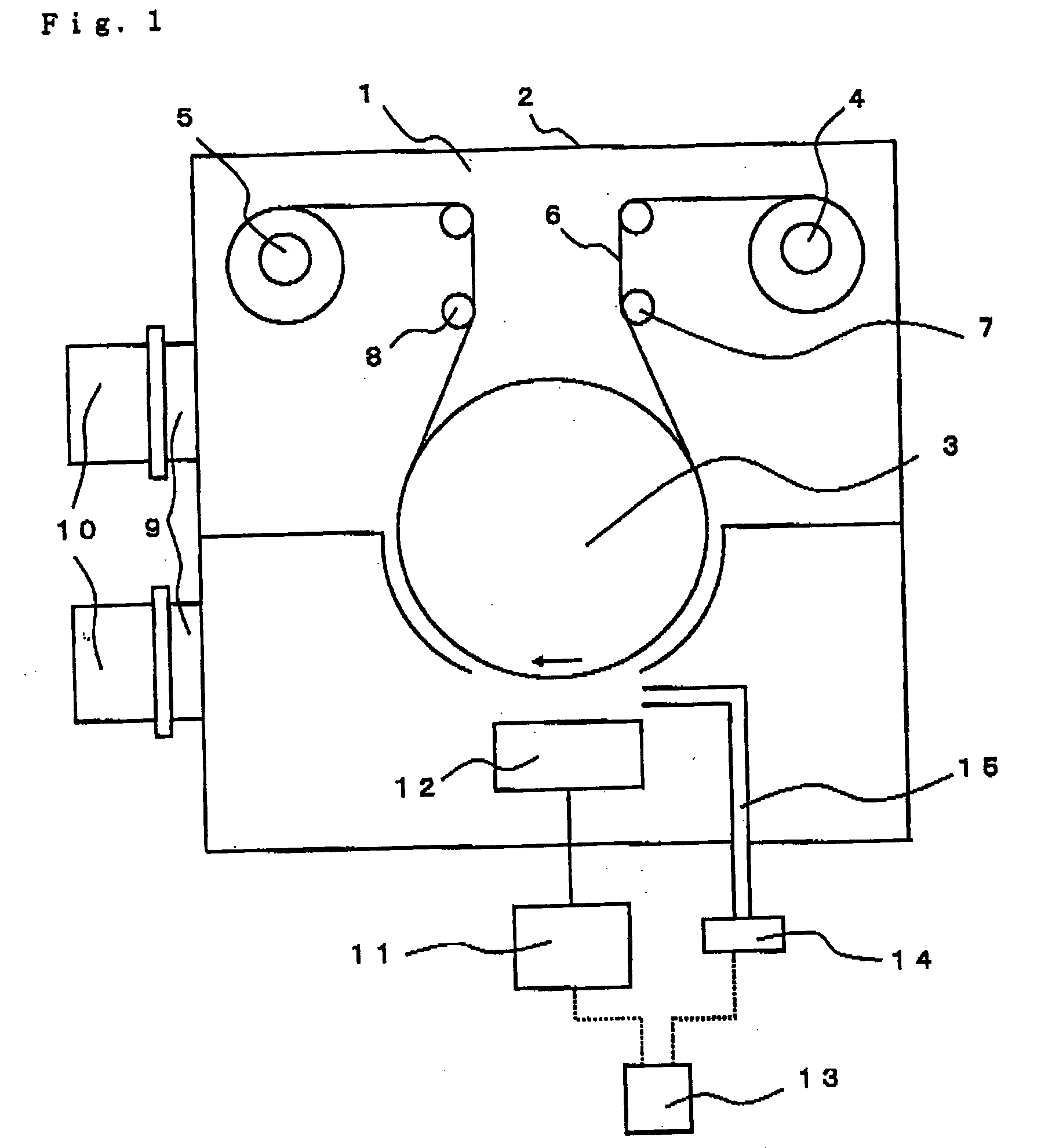Gas barrier film and method for producing the same
a technology of gas barrier film and film, applied in the field of gas barrier film, can solve the problems of degrading display quality, plastic base materials have drawbacks, and their gas barrier property is inferior to that of glass base materials, and achieve the effect of superior gas barrier property
- Summary
- Abstract
- Description
- Claims
- Application Information
AI Technical Summary
Benefits of technology
Problems solved by technology
Method used
Image
Examples
example 1
[0130] In Example 1, a polyimide film (UPILEX-R, Ube Industries) having a thickness of 100 μm (Tg: 285° C.) was used as a plastic base material for the present invention. In the comparative example, a polyethersulfone (PES) film having a thickness of 100 μm (Tg: 220° C.) and a ZEONOA film having a thickness of 100 μm (Tg: 160° C.) were used as a plastic base material.
[0131] 1. Preparation of inorganic oxide layer
[0132] As shown in FIG. 1, an inorganic layer was prepared by using a roll-to-roll type sputtering apparatus 1. This apparatus 1 had a vacuum-chamber 2, and a drum 3 for cooling a plastic film (base material) 6 by contact on the surface was disposed at the center of the chamber. Further, a feeding roller 4 and rolling-up roller 5 for winding the plastic film 6 were disposed in the aforementioned vacuum chamber 2. The plastic film 6 wound around the feeding roller 4 was wound around the drum 3 via a guide roller 7, and further the plastic film 6 was wound around a roller 5 ...
example 2
[0144] 1. Preparation of plastic substrate
[0145] A resin represented by the formula (1) synthesized as follows (C-3, Tg: 270° C.) was dissolved in dichloromethane at a concentration of 15 weight % and cast on a stainless steel band by the die coating method. Then, the first film was stripped off from the band, and dried until the remaining solvent concentration became 0.08 weight %. Then, the film was trimmed and knurled for the both edges, and the film was rolled up to prepare Film 2A having a thickness of 100 μm.
Synthesis Example of C-3
[0146]
[0147] In an amount of 235.59 g (646.8 mmol) of M-100, 9.171 g (33 mmol) of tetrabutylammonium chloride, 2805 mL of dichloromethane and 2475 mL of water were put into a reaction vessel provided with a stirrer and stirred at 300 rpm on a water bath under a nitrogen flow. After 30 minutes, 134.05 g (660 mmol) of terephthaloyl chloride was added as powder and washed away with 330 mL of dichloromethane. After 10 minutes, a solution obtained by ...
example 3
[0166] Films 3A to 3G were prepared by laminating one inorganic layer consisting of inorganic oxide and one organic layer consisting of an acrylate resin on Film 2A to 2D prepared in Example 2 according to the method described in International Patent Application Laid-open in Japanese No. 2002-532850. Then, water vapor permeability was measured at 45° C. and 100% of relative humidity and evaluated. The results of measured water vapor permeability are shown in Table 3.
[0167] The gas barrier film disclosed in International Patent Application Laid-open in Japanese No. 2002-532850 was prepared, and water vapor permeability thereof was measured in the same manner as in Example 3. The result of measured water vapor permeability is shown in Table 3.
TABLE 3Water vaporpermeabilityFilm(g / m2 · day)Remarks3A0.02Invention3B0.01Invention3C0.03Invention3D0.02Invention3E0.30Comparative3F0.20Comparative3G0.04InventionPET*1)0.57Comparative
*1Film described in International Patent Application Laid-op...
PUM
| Property | Measurement | Unit |
|---|---|---|
| glass transition temperature | aaaaa | aaaaa |
| temperature | aaaaa | aaaaa |
| temperature | aaaaa | aaaaa |
Abstract
Description
Claims
Application Information
 Login to View More
Login to View More - R&D
- Intellectual Property
- Life Sciences
- Materials
- Tech Scout
- Unparalleled Data Quality
- Higher Quality Content
- 60% Fewer Hallucinations
Browse by: Latest US Patents, China's latest patents, Technical Efficacy Thesaurus, Application Domain, Technology Topic, Popular Technical Reports.
© 2025 PatSnap. All rights reserved.Legal|Privacy policy|Modern Slavery Act Transparency Statement|Sitemap|About US| Contact US: help@patsnap.com



